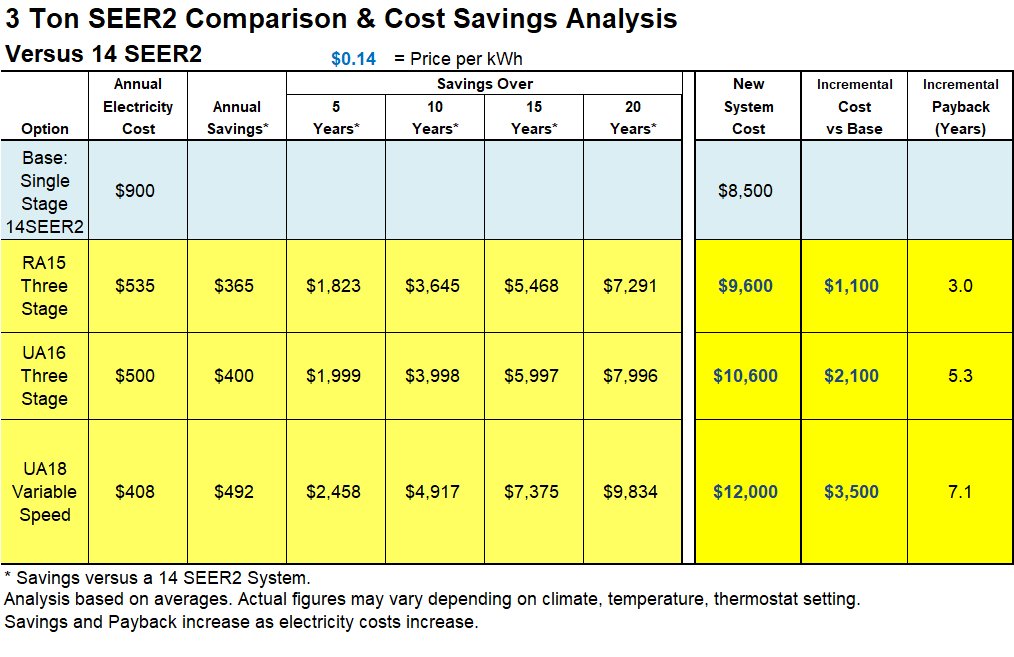What is AC SEER Rating?
In 2023, the SEER rating was replaced by the SEER2 rating. The US Department of Energy changed the test conditions with which we measure SEER (Seasonal Energy Efficiency Ratio). Specifically, the external static pressure in the air conditioner and heat pump testing was increased from 0.1 in. WC to 0.5 in. WC. The new Seasonal Energy Efficiency Ratio is called SEER2.
Here are some examples of how this SEER to SEER2 transition (due to different external static pressure) changed how to think about AC units and heat pumps:
As with anything having to do with energy conservation SEER2 is probably the least understood concept, both by homeowners and contractors. Simply put, SEER2 stands for Seasonal Energy Efficiency Ratio 2. The resulting SEER2 number that is applied to an air conditioner is called its SEER2 rating. The higher the SEER2 rating the more energy efficient a given air conditioner is. We’re assuming for comparison purposes that all other variables are the same between the AC systems compared.
BTU’s / SEER2 = WATTS/HR
Divide the AC system’s rated BTU’s by its stated SEER2 rating to determine how many watts it consumes per hour (Kwh stands for kilo-watt hour).
Here’s the formula (we’ll use a 3-Ton, 15 SEER2 AC system for this comparison):
36,000 BTU’s (3 tons) / 15 SEER2 = 2,400 Watts/Hr
This is simply the number of watts consumed each operating hour by the AC system.
The last step is to determine your annual AC system operating cost to use as a basis of comparison to determine which of the multiple SEER2 rating choices you’ve been offered is best. To do that we need to know how many hours, on average, your AC system will operate. While many factors are involved here let’s assume that you operate your AC system the same way most people in your geographical area do. This assumes that you: set your thermostat at or near 78 most of the time, turn up/off your AC system when you’re gone for 4 hours or more, have the AC system tuned up periodically, and live in a home of average insulation and have average quality windows.
Fortunately, a lot of study has been done to tell us how many hours our air conditioner will operate based on our geographical area and using the assumptions listed above. To keep it simple, we’ll use an average in Texas, or 2,500 hours of operation hours annually.
Remember the number 2,400 watts/hr from above? That was the amount of watts our example 15 SEER2 air conditioner consumed each hour it operated. Now that we know our number of operating hours annually (2,500) we simply multiply these two numbers to get the total numbers of watts consumed on an annual basis.
2,500 hours X 2,400 watts consumed per hour = 6,000,0000 watts= 6,000 Kwh Annually
Now all that is left is to convert these numbers to an annual cost. To do that lets look again at your power bill and determine the total cost per Kwh. This is your cost for each Kwh your air conditioner consumes. Let’s use 12 cents per Kwh, including taxes, franchise fees, peak usage, surcharges, etc.
6,000 Kwh consumed annually X 12 cents per Kwh = $720 per year
Determining the Best SEER2 Rating for You
You now want to determine the SEER2 rating that is right for you. How long do you plan on owning and operating the AC system, or, how long will you live in the home the AC system is purchased for? This is the absolute key to your decision because the shorter your ownership period the greater your total cost will be due to a shorter amortization time of the purchase price.

See the table above for system comparisons and cost savings analysis. Let’s assume your AC system is broken and you need a new AC system. We know that 14 SEER2 will be the lowest price you will be offered as it is the federal minimum in terms of AC efficiency. We don’t need to calculate the return on the 14 SEER2 because you have no incremental increase in investment because it is your base unit pricing – everything else is compared to the 14 SEER2 AC system to determine if the increased price for the replacement AC will pay itself back to you.
Remember, your AC system is broken and you need a replacement AC now, so the 14 SEER2 unit is the choice everything else is compared to, hence the “incremental” increases are the price differences associated with any given (higher SEER) AC system as compared to the 14 SEER2 AC system – just the difference, not the total price. This is shown in the table above.
Looking to Replace Your Energy Hog AC System?
In most cases, a new high efficiency AC unit will pay for its self within the first 10 years.
When you purchase a new air conditioning replacement system for your home, you may be offered a bewildering maze of options, including higher AC SEER ratings. It is your contractor’s job to provide you with clear, concise information that will allow you make a confident, informed choice about these AC options without resorting to the “trust me” principle.
Call or text us (281) 786-0770, if you are having trouble getting the answers you need and we will be happy to spend a few minutes with you, even if you are purchasing elsewhere.
Follow Us On Social Media For Tips, Tricks & Promotions
Or Join our Mailing List for Exclusive Coupons and Specials!
We will gladly help you with all your HVAC, heating and cooling needs.
We’d love to hear your questions, comments, or you can schedule your appointment online.
CALL OR TEXT
281.786.0770
WE OFFER
FINANCING
WE ACCEPT
